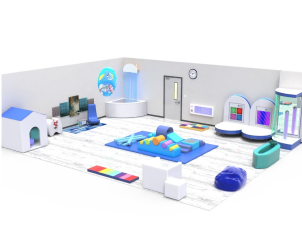 April is a Occupational Therapy Awareness Month. The American Occupational Therapy Association (AOTA) celebrates the 213,000+ individuals who work nationwide to create fuller lives for clients and their families. Its a month to honor the clients we have the privilege to serve, as well as connect with and extend gratitude to the colleagues and partners that contribute to the care of all clients.
April is a Occupational Therapy Awareness Month. The American Occupational Therapy Association (AOTA) celebrates the 213,000+ individuals who work nationwide to create fuller lives for clients and their families. Its a month to honor the clients we have the privilege to serve, as well as connect with and extend gratitude to the colleagues and partners that contribute to the care of all clients.
Occupational therapy is the only profession that helps people across the lifespan to do the things they want and need to do through the therapeutic use of daily activities (occupations). Occupational therapy practitioners enable people of all ages to live life to its fullest by helping them promote health, and prevent—or live better with—injury, illness, or disability.
In honor of Occupational Therapy Awareness month, we wanted to raise awareness of common diagnoses that we get so many questions on for interventions and products that can enable a child to participate fully in daily occupations.
Autism Spectrum Disorder (ASD)
Autism spectrum disorder is a developmental disorder that affects communication and behavior. Although individuals can be diagnosed at any age, autism is said to be a “developmental disorder” because symptoms generally appear in the first two years of life. Autism is also known as a “spectrum” because there is wide variation in the type and severity of symptoms people experience. Autism is generally characterized by difficulty communicating and interacting with other people, and/or by repetitive behavior or activities and restricted interests. Many children with autism spectrum disorder can also be hypersensitive to sensations. These symptoms can affect the child’s ability to function in school and social situations. ASD occurs in all ethnic, racial, and economic groups. Although ASD can be a lifelong disorder, treatments and services can improve a person’s symptoms and ability to function.
Sensory Processing Disorder (SPD)
Originally called Sensory Integration Dysfunction, Sensory Processing Disorder is a condition in which the brain has trouble receiving and responding to information that comes in through the senses. Sensory information goes into the brain but does not get organized into appropriate responses. Those with SPD perceive and/or respond to sensory information differently than most other people. Unlike people who have impaired sight or hearing, those with Sensory Processing Disorder do detect the sensory information; however, the sensory information gets “mixed up” in their brain and therefore the responses are inappropriate in the context in which they find themselves. Sensory processing disorder may affect one sense, like hearing, touch, or taste. Or it may affect multiple senses. And individuals can be over- or under-responsive to the things they have difficulties with. Like many illnesses, the symptoms of sensory processing disorder exist on a spectrum.

Attention-Deficit/Hyperactivity Disorder is a disorder characterized by inattention, hyperactivity, and/or impulsivity. Inattention means having trouble staying focused and on task. The may not listen well to directions, may miss important details, and may not finish what they start. They may seem forgetful, and lose track of their things. Hyperactivity can be seen in someone who fidgets or talks excessively, or are easily bored. They may have trouble sitting still, or staying quiet when needed. A child may climb, jump, or roughhouse when they shouldn’t . And impulsivity refers to someone who doesn’t think about the consequences of their actions, and can act too quickly. A child may interrupt often, and find it difficult to wait. Some children with ADHD have issues with only one of these behaviors. Most children with ADHD have some combination of these behaviors. It’s important to note that all children struggle to pay attention, listen and follow directions, sit still, or wait their turn. But for children with ADHD the struggles are harder and happen more often.
Generalized Anxiety Disorder (GAD)
Generalized Anxiety Disorder is characterized by persistent and excessive worry about a number of different things. We all know what it’s like to worry. We occasionally feel anxious about things in life that can cause stress–our jobs, bills, personal relationships, and so many other things. For most of us, this anxiety comes and goes. But for those with GAD, the anxiety is a constant presence. A person can’t stop worrying about various things large and small–from natural disasters to everyday details. Even if an individual knows their anxiety isn’t warranted, they can’t control it. They might feel so nervous or restless that they can’t relax. This can lead to trouble sleeping, headaches, lack of concentration, stomach aches, and symptoms. GAD is diagnosed at all ages, but more commonly in teens and young adults.
While families may experience a diagnosis at a young age with their child, children may experience simultaneous behavior patterns and challenges that may overlap with another diagnosis over time. It is also important to note the severity of symptoms varies among individuals and the treatment and interventions also vary. If you have concerns for your child, seek the medical advice from a physician. Also, learn how Occupational Therapy can impact your child and their daily occupations!



















Comments